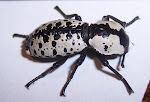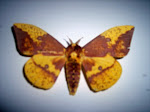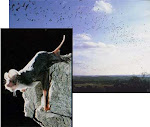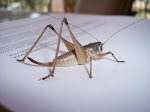June 28, 2009 Katydid
The next time you are asked if there are many LONGHORNS in Mystic Shores, tell them ‘Yes, of course! I listen to them every evening in the summer. Right now, there are a bunch of females congregating in the corner of the back porch and the males are making a racket. If you aren’t careful, one might end up in your iced tea!”
Now, I’m sure you know we are talking about Longhorn Grasshoppers, often referred to as Katydids or False Katydids. (Kingdom; Animal, Phylum; Arthropoda, Class; Insecta, Order; Orthoptera, Family; Tettigoniidae)
These are some of the loudest and most obtrusive neighbors we have here in Mystic Shores. Down here in the Peninsula and throughout Mystic Shores, it is obvious there are a lot of them this time of the year. In the evening they begin their daily rituals, but really start to jam after sundown! These interesting little insects, along with their cousins the crickets, are the background noise to our wonderful summer evenings. The males are the real show offs, of course, but can be subtle if ladies are involved (remind you of the male of any other species?). Their sound can project a hundred yards or more. The classical ‘Katy-did, Katy-didn’t’ evening song that is so prevalent up north is one example, but the local songs are actually unique and species specific. (There are about 250 species in North America, but many more in the tropics.) Their energy level is also temperature dependent since, like all cold blooded creatures, their activity level is directly tied to the outside temperature. Hence, you will note their songs are at a faster rate or cadence in the prolonged heat like we have experienced this past month. Never-the-less, the males have a repertoire of four distinct chirp patterns and ours certainly have the juice.
Their loudest noise, often described as a prolonged CHIRRRRRRRP, is the one they use when attracting females or warning off other males. The boys will often climb or fly into the lower branches of trees and sound off by rubbing their wings together. But, if their chemoreceptors detect another male nearby they might switch to a more aggressive song to scare the other suitor away. Once they have attracted a female, however, their courting song is ‘lento con sentimento’. The gals can hear this with their ‘ear’, or tympanic membrane, on their front legs. If the lady is tuned in, turned on and sufficiently impressed, she will accept the male’s nuptial gift of a spermatophylax. This prompt’s the male’s fourth type of song, which is brief and called his copulatory song.
The picture below was taken earlier this afternoon and is of a mature female about two inches long. There are a couple of points of interest in the photo.
First, look at the long antennae. These hair-like antennae can be as long, or even longer, than their body. (This is a key distinguishing feature from the true grasshoppers, which always have relatively short and thick antennae.) Next, you will see a sword like appendage at the rear of her abdomen. This looks like a tail, but it isn’t. It is an ‘ovipositor’ that she uses to deposit fertile rows of little oval eggs (resembling small grains of rice) in bark crevasses or leaf litter. Wingless nymphs hatch in the spring and grow through a number of phases (called instars) until adults are completely developed. The female of this particular species does not seem to have wings but the males do.
Thirdly, if you look closely you can see her auditory “ear” on the base of the second leg segment (tibia) of her front leg. This vibration sensor is what she uses to sense and home in on a mate’s song.
Lastly, you can see how these babies are built to jump. Those legs aren’t just for looks, because in a fraction of a second she can take one leap and quickly cover ten feet to escape predators, or out-of-tune males.
Katydids are pretty low on the food chain, and I am sure that birds, snakes and lizards take their toll. The Katydid’s brown-to-green coloration helps in concealment in foliage as they go about their daily business. Members of the Tettigoniid family feed mostly on leaves and tissues of various plants, including weeds. They are seldom numerous enough to cause noticeable injury to plants and they have one generation per year.
To wrap up this issue of “Our Creatures, Great and Small” keep in mind that if you handle one of these interesting insects improperly, they can give you a little nip. It won’t be enough to break the skin but it will surprise you enough for you to drop them, which is the point. Besides, if you let them go, maybe they will sing for you again tomorrow night.
They are one of our small creatures but have a great impact.
Clay
Click on these pictures to go directly to the article.
Followers
Blog Archive
About Me

- Clay Crum
- I'm always looking for suggestions (or photos) about other Mystic Shore wildlife. Do you know where a rattlesnake den is located? Do you have pictures of a mountain lion taken locally? Have you had interesting encounters with our wildlife? Share them with me by sending me an email or commenting on this blog.













